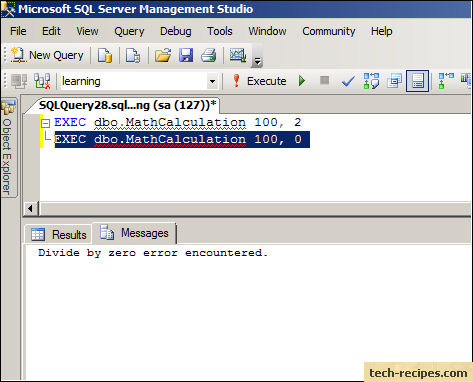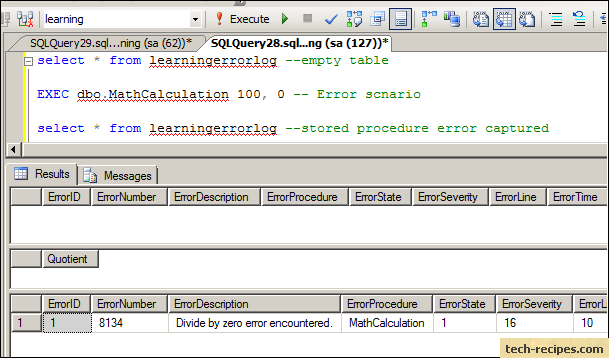As the number of stored procedures increases in a database, the burden of managing those stored procedures increases, too. On a production database, thousands of procedures are executed daily, so you are required to know why a stored procedure failed at a certain time. This can be done by implementing error logging and reporting within each stored procedure.
Once an issue has been raised on a production database, you need to solve it immediately to stop loss to a business. To monitor and resolve stored procedure errors, first you need to log if any error occurs and then monitor and perform error reporting.
Let us create a simple procedure for division calculation.
CREATE PROCEDURE dbo.MathCalculation
(
@Dividend INT,
@Divisor INT
)
AS
BEGIN
SET NOCOUNT ON;
BEGIN TRY
SELECT @Dividend/@Divisor as Quotient;
END TRY
BEGIN CATCH
PRINT Error_message();
END CATCH
SET NOCOUNT OFF;
END
GO
I have created a simple stored procedure to divide two numbers and get their quotient. Let us see how it works when we perform divide by 0 operation.
EXEC dbo.MathCalculation 100, 2 -- Works perfectly giving 50 as quotient
EXEC dbo.MathCalculation 100, 0 -- Divide by zero error encountered

The above calculation fails and prints an error message in an error message window Divide by zero error encountered.
Now you are seeing errors on-screen, but in a production environment, you do not get such flexibility. Therefore, we need to implement error logging.
Let us create a table to log all stored procedure errors.
CREATE TABLE [dbo].[LearningErrorLog]
(
[ErrorID] [bigint] IDENTITY(1,1) NOT NULL PRIMARY KEY,
[ErrorNumber] [nvarchar](50) NOT NULL,
[ErrorDescription] [nvarchar](4000) NULL,
[ErrorProcedure] [nvarchar](100) NULL,
[ErrorState] [int] NULL,
[ErrorSeverity] [int] NULL,
[ErrorLine] [int] NULL,
[ErrorTime] [datetime] NULL
);
Let us create a stored procedure to log errors.
CREATE PROCEDURE [dbo].[Learning_Insert_StoredProcedure_ErrorLog]
AS
BEGIN
SET NOCOUNT ON
INSERT INTO [LearningErrorLog]
(
ErrorNumber
,ErrorDescription
,ErrorProcedure
,ErrorState
,ErrorSeverity
,ErrorLine
,ErrorTime
)
VALUES
(
ERROR_NUMBER()
,ERROR_MESSAGE()
,ERROR_PROCEDURE()
,ERROR_STATE()
,ERROR_SEVERITY()
,ERROR_LINE()
,GETDATE()
);
SET NOCOUNT OFF
END
I have called built-in error reporting functions in the above stored procedure.
ERROR_NUMBER() – returns the error number of the error that caused the CATCH block of a TRY…CATCH construct to be run
ERROR_MESSAGE() – returns the message text of the error that caused the CATCH block of a TRY…CATCH construct to be run
ERROR_PROCEDURE() – returns the name of the stored procedure or trigger where an error occurred that caused the CATCH block of a TRY…CATCH construct to be run
ERROR_STATE() – returns the state number of the error that caused the CATCH block of a TRY…CATCH construct to be run
ERROR_SEVERITY() – returns the severity of the error that caused the CATCH block of a TRY…CATCH construct to be run
GETDATE() – returns the time of the error that caused
Now, we can query [LearningErrorLog] table to monitor the logged error.
Let us modify our MathCalculation stored procedure and call [Learning_Insert_StoredProcedure_ErrorLog] within catch block to perform error logging if any error occurred within stored procedure.
ALTER PROCEDURE dbo.MathCalculation
(
@Dividend INT,
@Divisor INT
)
AS
BEGIN
SET NOCOUNT ON;
BEGIN TRY
SELECT @Dividend/@Divisor as Quotient;
END TRY
BEGIN CATCH
EXEC [dbo].[Learning_Insert_StoredProcedure_ErrorLog] --To log Stored procedure errors
END CATCH
SET NOCOUNT OFF;
END
GO
Now, again execute error generation scenario.
EXEC dbo.MathCalculation 100, 0 -- divide by 0 error scenario
Query the [LearningErrorLog] table. You can see the catch exception stored procedure error has been logged in the table.


